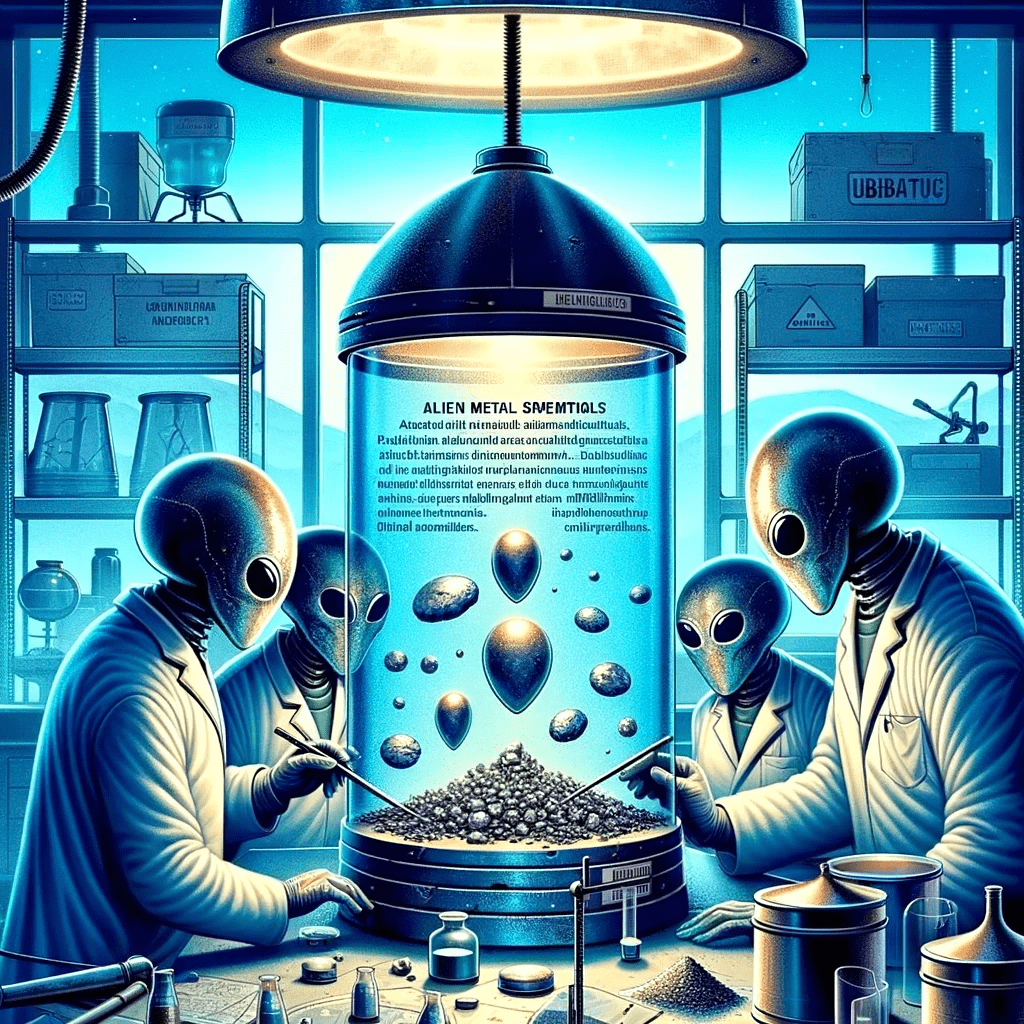Alien Metal Specimens

The enigma of Unidentified Flying Objects (UFOs) extends beyond fleeting sightings in the sky; it penetrates into the very materials these mysterious objects are made of. From elements with perplexing properties to powerful odors evocative of “rotten eggs” or “burning metal,” the study of alleged extraterrestrial materials has long fascinated both the scientific community and the general public. This article explores some of the most compelling examinations of these materials, undertaken by esteemed researchers and scientific institutions, shedding light on what we know—and don’t know—about their origins and properties.
Intriguingly, an alien metal specimen purportedly originating from a Pleiadian spacecraft has been the subject of intensive study. The specimen contains a complex amalgamation of elements, including silicon, iron, rare earth thulium, argon, and silver. However, what captures immediate attention is its sulfur content, which is believed to be the source of the pungent, sulfur-like aroma that emanates from the material. Some theories suggest that this sulfur component could serve a functional purpose within the spacecraft’s technology, although its specific role remains a subject of ongoing research. The presence of sulfur not only adds a sensory dimension to the already enigmatic specimen but also opens up intriguing questions about the engineering and atmospheric conditions of Pleiadian space vessels.
In 1979, Dr. Marcel Vogel, an IBM research scientist with expertise in phosphor chemistry and luminescence, undertook a real-time lab study of metal samples said to be from UFOs. With more than 30 patents to his name in related fields, Vogel was a respected figure in the scientific world, known for his groundbreaking work in materials science. His role in the investigation of these alleged extraterrestrial metals thus attracted considerable notice from both scientific and public spheres.
During his research, Vogel employed various scientific techniques, including spectroscopy, to assess the make-up and characteristics of these metal samples. According to certain reports, he discovered that the metals had unique structural features, displaying traits not typically seen in human-made metals. This led him to speculate that the materials could very well be from a non-earthly source.
Witnesses of UFO encounters have often reported strong, pungent odors similar to “rotten eggs,” “sulfur,” or “burning metal,” which adds another layer of mystery to these phenomena.
Intriguing are the various physical specimens purportedly linked to these various mysterious sightings. From traditional scientific institutions to private labs and individual researchers, a variety of cases have been scrutinized over the years. Here’s a look at some of the most notable instances where alleged UFO materials were scientifically examined.
In 1957, the Ubatuba Magnesium Samples were sent to the Brazilian Journal of Aeronautics and later forwarded to American researchers for further study. Then, in 1979, IBM scientist Dr. Marcel Vogel conducted his own examination of alleged UFO metal specimens, which attracted attention both within and outside the scientific community. In 1985, the Bob White Object, a metal piece claimed to be from a UFO, was studied by several private labs, which produced differing results. Fast-forward to 1996, materials known as “Art’s Parts,” allegedly from the Roswell incident, were sent to Art Bell, a talk radio host. Private analyses of these pieces led to various inconclusive theories. In the 2010s, To The Stars Academy, a private company led by former Blink-182 guitarist Tom DeLonge, claimed to have materials from UFOs and stated that they are under ongoing private scientific examination. Finally, samples from the Skinwalker Ranch in Utah, a site claimed to be a hotspot for paranormal activity including UFOs, have reportedly been studied by private labs, including the National Institute for Discovery Science (NIDS).
The Art’s Parts UFO material sample is a small, irregularly shaped piece of metal sent anonymously to radio host Art Bell in 1996. Claimed to be debris from the 1947 Roswell crash, the specimen consists of layered magnesium, aluminum, and bismuth. The material features a dark, oxidized underside and a reflective top side, with hexagonal patterns and iridescent colors. Its unique structure suggests advanced manufacturing techniques, possibly for applications in energy conversion and propulsion systems.
The study of materials allegedly associated with UFOs represents a unique intersection of science, speculation, and public curiosity. Whether it’s the sulfuric odor from a Pleiadian spacecraft specimen or the anomalous findings of Dr. Marcel Vogel, these studies offer tantalizing glimpses into the possibilities of life beyond Earth.

